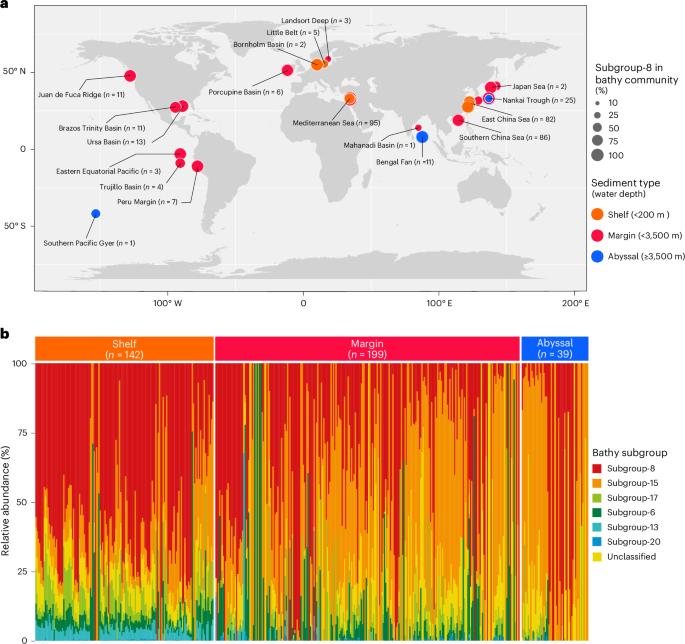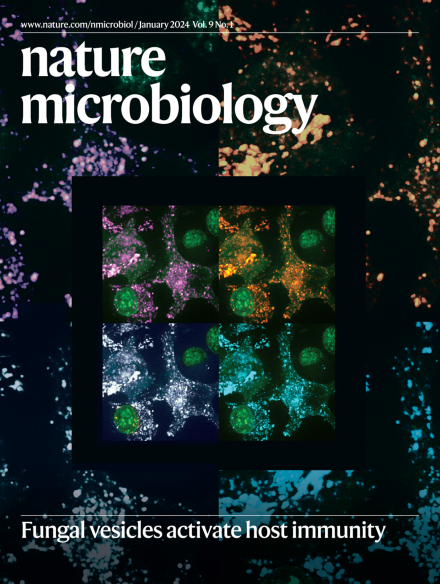A dominant subgroup of marine Bathyarchaeia assimilates organic and inorganic carbon into unconventional membrane lipids
IF 19.4
1区 生物学
Q1 MICROBIOLOGY
引用次数: 0
Abstract
Bathyarchaeia, an abundant and ecologically versatile archaea found commonly in marine sediments, has a key role in the global carbon cycle. However, its lipid biomarkers and carbon assimilation mechanisms are poorly understood. Here, using a highly enriched Bathyarchaeia culture (>95% archaea) obtained from estuarine sediment of the East China Sea, we show that Baizosediminiarchaeum (formerly subgroup Bathy-8), the most abundant and widespread Bathyarchaeia group on Earth, synthesizes butanetriol dialkyl glycerol tetraethers (BDGTs) as its dominant membrane lipids. BDGTs are unusual archaeal tetraether lipids characterized by a butanetriol backbone instead of the typical glycerol, challenging fundamental assumptions in archaeal lipid biochemistry. Although BDGTs have been previously identified in the methanogen Methanomassiliicoccus luminyensis, we now provide direct evidence that Bathyarchaeia also synthesizes BDGTs, definitively establishing this globally abundant group as a natural BDGT producer. Stable isotope probing with 13C-bicarbonate shows that Baizosediminiarchaeum assimilates carbon into BDGTs from both inorganic carbon and lignin. These unique carbon assimilation strategies suggest the biogeochemical importance of Baizosediminarchaeum in marine carbon cycling and organic matter decomposition. Baizosediminiarchaeum, a key player in the deep biosphere, builds butanetriol dialkyl glycerol tetraether (BDGT) membrane lipids and feeds on both CO2 and lignin, revealing a survival strategy in low-energy environments and a unique lipid biomarker for this group.

海洋深海古菌的一个优势亚群将有机和无机碳同化成非常规的膜脂。
深海古菌是一种数量丰富、生态用途广泛的古菌,常见于海洋沉积物中,在全球碳循环中起着关键作用。然而,其脂质生物标志物和碳同化机制尚不清楚。本文利用东海河口沉积物中高富集的深海古菌培养物(>95%古菌),发现地球上最丰富、分布最广的深海古菌群Baizosediminiarchaeum(原Bathy-8亚群)以丁三醇二烷基甘油四醚(BDGTs)为主要膜脂。BDGTs是一种罕见的古菌四醚脂质,其特征是丁三醇骨架而不是典型的甘油,挑战了古菌脂质生物化学的基本假设。虽然BDGT之前已经在产甲烷菌Methanomassiliicoccus luminyensis中被发现,但我们现在提供的直接证据表明深海古菌也能合成BDGT,从而明确地确立了这一全球丰富的群体是天然BDGT的生产者。13c -碳酸氢盐的稳定同位素探测表明,沉积白孢菌将无机碳和木质素中的碳吸收为BDGTs。这些独特的碳同化策略表明了百藻沉积古菌在海洋碳循环和有机物分解中的生物地球化学重要性。
本文章由计算机程序翻译,如有差异,请以英文原文为准。
求助全文
约1分钟内获得全文
求助全文
来源期刊

Nature Microbiology
Immunology and Microbiology-Microbiology
CiteScore
44.40
自引率
1.10%
发文量
226
期刊介绍:
Nature Microbiology aims to cover a comprehensive range of topics related to microorganisms. This includes:
Evolution: The journal is interested in exploring the evolutionary aspects of microorganisms. This may include research on their genetic diversity, adaptation, and speciation over time.
Physiology and cell biology: Nature Microbiology seeks to understand the functions and characteristics of microorganisms at the cellular and physiological levels. This may involve studying their metabolism, growth patterns, and cellular processes.
Interactions: The journal focuses on the interactions microorganisms have with each other, as well as their interactions with hosts or the environment. This encompasses investigations into microbial communities, symbiotic relationships, and microbial responses to different environments.
Societal significance: Nature Microbiology recognizes the societal impact of microorganisms and welcomes studies that explore their practical applications. This may include research on microbial diseases, biotechnology, or environmental remediation.
In summary, Nature Microbiology is interested in research related to the evolution, physiology and cell biology of microorganisms, their interactions, and their societal relevance.
 求助内容:
求助内容: 应助结果提醒方式:
应助结果提醒方式:


